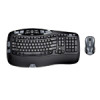Logitech Desktop Wave Role of Comfort in Product Design - Page 2
The Role of Comfort in, Product Design - - set
 |
View all Logitech Desktop Wave manuals
Add to My Manuals
Save this manual to your list of manuals |
Page 2 highlights
The Role of Comfort in Product Design - Page 2 When Ford first began mass-producing the Model T in the early 1900s, the seats hadn't changed much. However, soon thereafter, gradual changes began to appear. While the '28 Model A's had the old fixed, nonadjustable seats, the '30 passenger models added adjustability to the front seats with a "worm gear controller," a metal rod that ran beneath the front seat to move the seat forward or back. In 1931, the most common Ford Model A, a two-door sedan, had two small stool-like front seats that people had to balance on when driving. Logitech's Definition of the Role of Comfort in Product Design (n.) 1. Comfort is a state of delightful forgetfulness; a comfortable product goes beyond its function to add a quality of physical and emotional pleasure to an experience that would otherwise be unpleasant. Finally, with the introduction of sporty, compact cars in the '50s and '60s, such as the 1965 AC Cobra, the now ubiquitous bucket seat arrived to save us from the balancing act. Unlike the flat surfaces of previous seat designs, bucket seats conform to fit the shape of our bodies, leading to a more comfortable and enjoyable driving experience. More recently, car manufacturers have added additional comfort features, such as lower back John Fliss supports, headrests and heated seats. Today, 1965 AC Cobra with bucket seats. instead of a worm controller, many cars have electronic controls that adjust the seats. The 2007 Volkswagen Jetta can even remember up to three different car-seat settings, automatically adjusting to a preset position with the push of a button. Think of it. Just a few decades ago, people sat on bench seats - struggling to maintain good posture - while maneuvering busy streets. Isn't it unbearable to even imagine sitting on one of the car seats of the past? Remember the wooden bench seat the next time you're faced with atrocious traffic. Try to keep in mind how lucky we are that today, we can turn on the seat heater, electronically adjust the tilt of the seat so that it's just right, lean back against the headrest and forget for a moment that we're stuck in traffic. The Backpack: The Instant Comfort of the Internal Frame Outdoor enthusiasts use frame backpacks to transport equipment and supplies across remote terrain, such as snow-covered mountain trails. There are two types of frame backpacks - those with frames that are housed within the backpack fabric, or internal frames, and those with frames that are fitted outside the fabric, or external frames. Internal-frame backpacks, which have been around since about 1970, vastly outsell external frames, which have been commercially produced since the late 1920s. Most major sporting goods stores don't even carry externals anymore. Though companies such as Logitech expend significant resources defining with great precision those visual cues that immediately convey the promise of comfort - a balance must be achieved so that the best innovations will be adopted, so that they will present themselves close enough to what usability expert Donald Norman, in his book The Design of Everyday Things, calls "mental models." These are "our conceptual models of the way objects work, events take place or people behave, [that] result from our tendency to form explanations of things. We base our models on whatever knowledge we have, real or imaginary, naïve or sophisticated." In this explanation, Norman illuminates the challenge companies face in overcoming traditions and expectations. We tell ourselves that the keyboard should have a certain shape because that's how it has been for many years; we don't question or challenge the old form. However, companies hoping to introduce a product that delivers comfort in a new shape must overcome resistance to the new form, the new story. They must strike the right balance between tradition and innovation.







